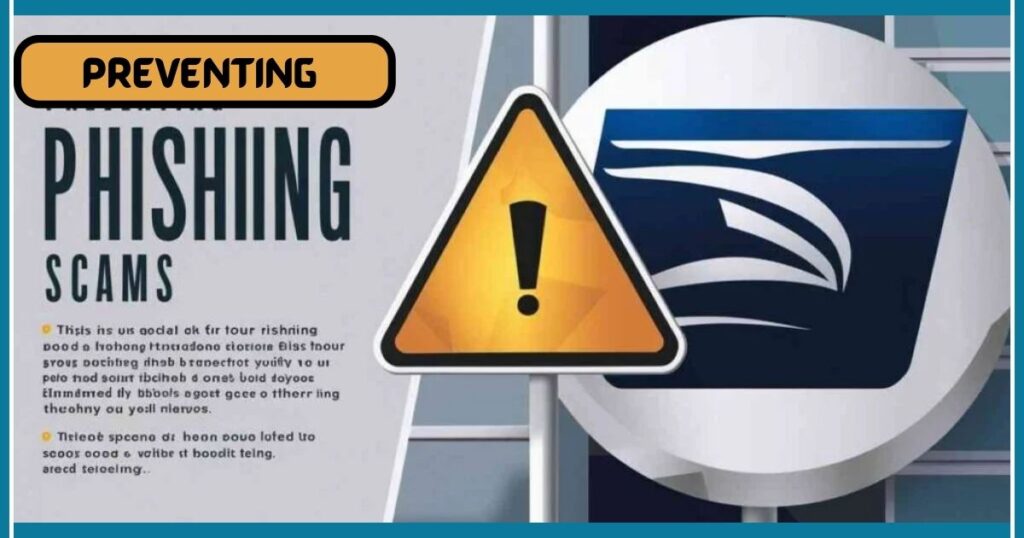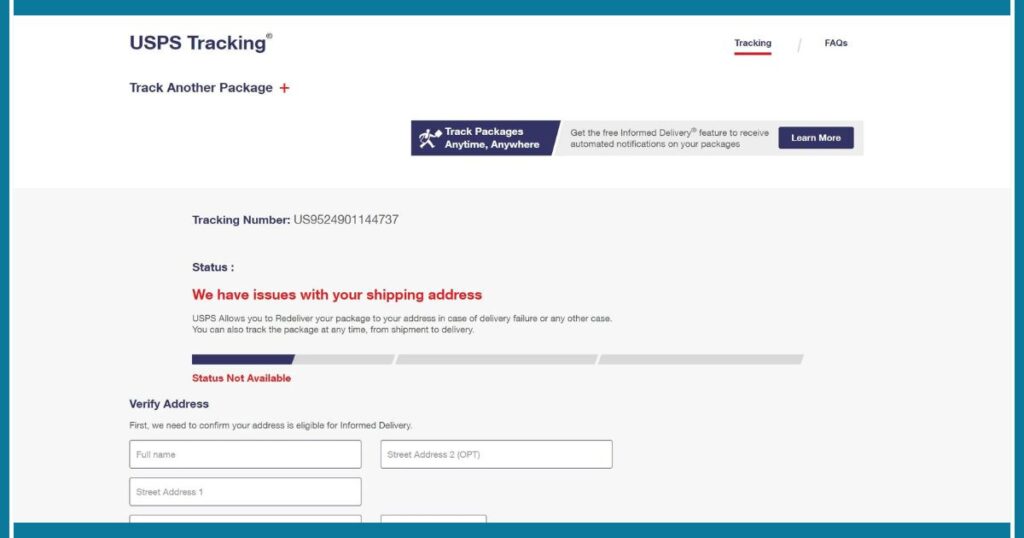In today’s digital age, cybercriminals are constantly devising new and more sophisticated methods to deceive unsuspecting individuals.
One such sinister scheme that has been making rounds is the US9524901144737 USPS phishing scam.
This devious attack preys on the trust we place in reputable organizations like the United States Postal Service (USPS), making it crucial for everyone to be vigilant and informed.
The US9524901144737 USPS Scam: An In-Depth Look

What is the US9524901144737 scam?
The US9524901144737 scam is a type of phishing attack where cybercriminals impersonate the USPS to trick individuals into providing personal information or financial data.
It revolves around a fake tracking number, US9524901144737, which mimics the format of legitimate USPS tracking numbers.
How does this insidious scam work?
The scam typically unfolds in the following stages:
- Initial Contact: You receive an email, text message, or voicemail claiming that a package addressed to you was undeliverable due to an incorrect address. The message includes the fake tracking number US9524901144737 and urgently prompts you to click a provided link to update your address for redelivery.
- Phishing Website: Clicking the link redirects you to a meticulously crafted website designed to mimic the official USPS site. However, upon closer inspection, the URL might have subtle differences, such as “USPS-secure365.com” instead of the legitimate “USPS.com”.
- Data Collection: Once on the phishing site, you’re prompted to enter personal information, such as your full name, address, phone number, and potentially even credit card details under the guise of a redelivery fee.
- Information Exploitation: After obtaining your sensitive data, the scammers can use it for various nefarious purposes, including identity theft, financial fraud, or selling the information on the dark web.
Real-life Cautionary Tale
John, a busy professional from Los Angeles, fell victim to this scam. He received what appeared to be a legitimate USPS notification about a failed delivery attempt.
Eager to resolve the issue, John clicked the provided link and entered his personal details on the phishing website without a second thought.
Little did he know, this single action would lead to months of headaches as he fought to regain control of his compromised identity and financial accounts.
Identifying Red Flags: Spotting the US9524901144737 Scam
While the US9524901144737 scam can be convincing, there are several red flags to watch out for:
- Unsolicited Notifications: Be wary of unexpected delivery failure notices, especially if you’re not anticipating a package.
- Generic Greetings: Legitimate communications often address you by name, whereas phishing attempts tend to use impersonal greetings like “Dear customer.”
- Urgency and Pressure Tactics: Messages urging immediate action or creating a sense of urgency are common phishing tactics to bypass critical thinking.
- Suspicious Links: Hover over any provided links to check if they lead to legitimate USPS domains (e.g., USPS.com). If the URL looks dubious, don’t click it.
- Poor Grammar and Spelling: Official communications from reputable organizations are typically well-written and error-free. Phishing attempts often contain grammatical mistakes and typos.
How to Verify USPS Tracking Numbers
If you receive a tracking number and want to confirm its legitimacy, you can:
- Visit the Official USPS Website: Manually enter the tracking number on USPS.com to see if it’s associated with an actual package.
- Contact USPS Directly: Call USPS customer service at 1-800-ASK-USPS (1-800-275-8777) to verify the tracking number’s validity.
Remember, the USPS will never ask you to provide personal or financial information via email or text message.
If you’re unsure about a notification’s authenticity, it’s always better to err on the side of caution and verify through official channels.
Recommended Blog: 127.0.0.1:62893: Examining Its Importance And Uses
You’ve Been Phished! What Now?
If you’ve inadvertently fallen victim to the US9524901144737 scam or any other phishing attempt and provided personal information, it’s crucial to act swiftly to minimize potential damage.
Immediate Steps to Take

- Contact Financial Institutions: Immediately notify your bank and credit card companies about the potential compromise of your information. They can implement additional security measures and monitor for suspicious activity.
- Place Fraud Alerts: Contact one of the three major credit bureaus (Experian, Equifax, or TransUnion) and request to place a fraud alert on your credit file. This will make it harder for criminals to open new accounts in your name.
- Monitor Credit Reports: Regularly check your credit reports from all three bureaus for any unauthorized activity or new accounts you didn’t open.
- Change Online Passwords: Update passwords for all your online accounts, especially those related to financial institutions or sensitive personal information. Use strong, unique passwords for each account.
- File Identity Theft Reports: Report the incident to the Federal Trade Commission (FTC) at IdentityTheft.gov and your local law enforcement agency.
Long-term Protective Measures
- Credit Freezes: Consider placing a credit freeze with the three major credit bureaus. This will prevent anyone, including you, from opening new credit accounts in your name until the freeze is lifted.
- Vigilant Monitoring: Continuously monitor your bank statements, credit card accounts, and credit reports for any suspicious activity or unauthorized transactions.
- Identity Theft Protection Services: Explore reputable identity theft protection services that can monitor your personal information and assist with recovery efforts if needed.
Where to Report the Scam
Reporting phishing scams like the US9524901144737 USPS scam is crucial to raise awareness and help authorities combat these crimes. Here are some places you can report the scam:
- USPS: Forward phishing emails to spam@uspis.gov and report suspicious text messages to 7726 (SPAM).
- Federal Trade Commission (FTC): File a complaint on the FTC’s website.
- Anti-Phishing Working Group (APWG): Forward phishing emails to reportphishing@apwg.org.
- Your Email Provider: Use your email provider’s tools to mark the message as phishing or spam.
By reporting phishing attempts, you not only protect yourself but also contribute to the ongoing efforts to combat these malicious activities and prevent others from falling victim.
Bulletproof Your Defenses: Preventing Future Phishing Attacks

While the US9524901144737 scam is a formidable threat, there are proactive measures you can take to safeguard yourself against phishing attacks and other online scams.
General Online Safety Tips
- Install and Update Antivirus Software: Reliable antivirus software can detect and block many phishing attempts and malware threats.
- Keep Software and Operating Systems Up-to-Date: Regularly update your software and operating systems to benefit from the latest security patches and improvements.
- Use Ad Blockers: Browser-based ad blockers can prevent malicious advertisements from redirecting you to phishing sites.
- Be Cautious with Downloads: Only download software from trusted sources and be wary of unsolicited downloads or attachments.
- Backup Your Data: Regularly backup your important data to protect against ransomware and other malware attacks.
Specific Anti-Phishing Practices
- Verify Senders: Always verify the sender’s email address or phone number before taking any action on a message.
- Avoid Clicking Unknown Links: Never click on links or open attachments from unsolicited or suspicious messages.
- Report Suspicious Messages: Report phishing attempts to relevant authorities and the impersonated organization (e.g., USPS) to help combat these scams.
- Enable Two-Factor Authentication (2FA): Implement 2FA on your accounts for an extra layer of security, making it harder for criminals to gain unauthorized access.
- Stay Informed: Educate yourself about the latest phishing tactics and trends to better recognize and avoid them.
Recommended Blog: What Is Wdroyo Technology?
Conclusion
The US9524901144737 USPS phishing scam underscores the evolving cyber threats online. Staying informed and vigilant is crucial.
Recognizing red flags like unsolicited notifications and urgent language can prevent falling victim.
Swift action, including contacting authorities and monitoring accounts, mitigates potential damage if personal information is compromised.
Adopting comprehensive online safety measures, such as using antivirus software and enabling two-factor authentication, is vital.
By remaining vigilant, reporting suspicious activities, and prioritizing online safety, we collectively contribute to a safer internet environment.
FAQs
What makes the US9524901144737 scam so convincing?
The scam’s convincing nature lies in its ability to mimic legitimate USPS communications and exploit the urgency surrounding package deliveries. By using a fake tracking number and crafting a realistic-looking phishing website, the scammers create a sense of credibility that can easily deceive unsuspecting individuals.
How can I check if a tracking number is legitimate?
You can verify the legitimacy of a USPS tracking number by manually entering it on the official USPS website (USPS.com) or by contacting USPS customer service directly. If the tracking number is genuine, it will be associated with an actual package in the USPS system.
What personal information do phishers typically target?
Phishers often seek sensitive personal information such as full names, addresses, phone numbers, email addresses, and financial data like credit card numbers and banking details. This information can be used for identity theft, financial fraud, or sold on the dark web for nefarious purposes.
How long does it take to recover from identity theft?
The recovery process from identity theft can be lengthy and complex, often taking several months or even years to fully resolve. It involves clearing your credit reports, disputing fraudulent accounts, and potentially dealing with legal proceedings. The sooner you take action, the faster the recovery process may be.
Are there any legal consequences for phishers?
Yes, phishing scams and identity theft are considered criminal offenses with serious legal consequences. Depending on the severity of the crime and the jurisdiction, phishers can face fines, imprisonment, or both. However, prosecuting phishers can be challenging due to the global nature of cybercrime and the anonymity afforded by the internet.








